#but it would probably be horrendous like everything made about french history lately
Explore tagged Tumblr posts
Text
Philippe II, Isabelle, and the divorce that wasn't.
In 1184 Philip Augustus, provoked by the growing hostility towards him from Philip of Alsace, made a move which angered the latter: he sought divorce from Isabella, the count's niece. The decision to end his marriage was probably political rather than personal, aimed against the count of Flanders and to a lesser extent against the count of Hainault. It was also motivated by a desire to underline his independence of the count of Flanders, as earlier he had distanced himself from his Champagne relatives. It was a move which backfired, in that it failed to achieve a divorce, but which had something of the desired effect politically.
Queen Isabella was only fourteen, and the marriage may not yet have been consummated. Philip called a council at Senlis in March 1184, claiming that the marriage was invalid on grounds of consanguinity. One aim, some have suggested the main aim, was to detach Isabella's father from Philip of Flanders. The move also reinforced Philip's reconciliation with his Champagne relatives, who had always opposed the marriage.
Isabella, however, was no mere puppet. She felt no guilt over her marital conduct and made public demonstration of the fact. She took off her jewelled clothes and emerged from the palace clad only in a chemise, barefoot, and carrying a candle. She distributed alms to the poor, to beggars and lepers, entering churches in the city to pray. Those who had received her gifts gathered before the palace to demonstrate their support. Philip's counsellors advised him to restore the queen, pointing out that repudiation would lead to the loss of Artois. He had offered Isabella the chance to marry again, to choose a husband for herself, but she insisted on maintaining her position as queen of France, declaring: 'it does not please God that a mortal should enter the bed in which you slept' . The king backed down and Isabella was restored.
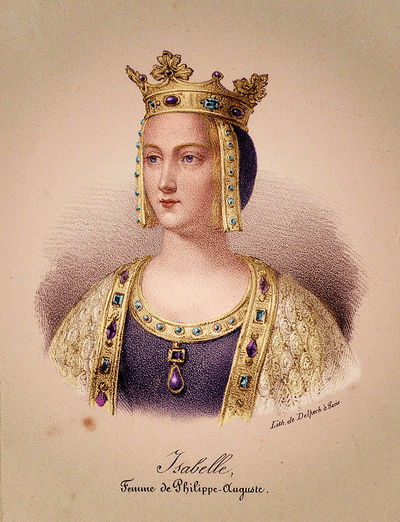
Giselbert of Mons described a meeting between father and daughter at Pontoise, at which Isabella wept, saying she was wretched because her father and husband were in conflict, with her father supporting the count of Flanders against the king. The divorce threat came as a shock to the count of Hainault. He was embroiled in local disputes, notably against his vassal Jacques d'Avesnes. The father's decision in 1184 to switch his allegiance from the count of Flanders to the king is a key moment in the struggle between France and Flanders during the 1180s.
The move brought advantage to the king, but it caused problems for the count of Hainault. He now found most of the northern princes allied against him: the count of Flanders, the dukes of Brabant and Louvain, the archbishop of Cologne and Jacques d'Avesnes among them. Valenciennes and Mons came under attack. Hainault's only possible salvation was aid from France, so the count appealed to Philip, and at Christmas sought out his son-in-law at Loudun.
When the crunch came in 1185, Hainault sided with France against Flanders, a crucial element in the balance. The Plantagenets were engaged in their own internal squabbles, which Philip helped to stir. Affairs were building towards a showdown.
Jim Bradbury - Philip Augustus, King of France, 1180-1223
#xii#jim bradbury#philip augustus king of france 1180-1223#philippe ii#isabelle de hainaut#philippe d'alsace#baudouin v de hainaut#i just love her#we need a series about that era and that reign#but it would probably be horrendous like everything made about french history lately#but isabelle's walk with the people supporting her ? yeah
8 notes
·
View notes
Text
Anonymous asked: Who are some women in history that would be comparable to Napoleon or Alexander? Women who rose to power because they sought greatness and not because they used the feminine form to seduce for an easier life? How can the feminine mind come out of the mentality of being “the weaker sex”?
The short answer is that there are no women in history comparable to Napoleon or Alexander but equally I would quickly add that there are no other men in history either. These two contrasting men are unique. Alexander and Napoleon share similarities in their warfare, and how they used it to conquer and establish new lands. Both left legacies in which their very name has been equally loathed and loved down the ages. But they were unique.
Both were outsiders whose personal qualities rose above obstacles. Alexander was Macedonian and the Greeks looked down upon him as uncultured barbarian in the same way Napoleon was Corsican nobility and the old French aristocracy pulled up their noses in snobbish superiority. And yet able to rise through the grit of discipline and learning, luck and skill.
Both were great battle field commanders with a greater understanding of how to use one’s forces at hand to the terrain. Both were not quite true innovators as many might imagine. Alexander's military brilliance is beyond dispute but the groundwork for his superior tactics and strategies were laid by his father Philip of Macedon. Much of Napoleon’s greatness relied on the conscription model that the French revolutionary wars ushered in.
Alexander used new technology in new ways, invented new formations, and used his battlefield successes to accomplish his strategic goals with the innovative use of propaganda that was unseen before. Alexander was very unmatched in winning battles against much larger enemy formations as he was often outnumbered 2:1. He was a tactical genius in finding the weakness in the enemy’s lines and making the surgical strike necessary to ensure victory. He was quick witted at being able to make quick tactical decisions in the thick of the battle.
He was able to snatch victory from the claws of certain defeat, time and again, always against overwhelming enemy superiority in numbers, always in a terrain that his enemies had carefully chosen to maximise their advantages.
Any city he ever attacked he conquered. His own father the great Philip II failed to take Byzantium, and was defeated by Thracian tribesmen, but not Alexander. He made land out of a sea and conquered the heavily fortified island city of Tyre, and he used rock climbers to take the Sogdian Rock in Bactria/Afghanistan, an impregnable citadel that was compared to an eagle’s nest. Moreover he never lost a battle.
Napoleon was a brilliant general and even in his time earned grudging respect from his enemies. Napoleon was very successful in most of his military campaigns, and that laid the foundation necessary for his political achievements.
He fought 60 battles in his career, losing only 8 with two being considered “tactical victories” only (Second Bassano and Aspern-Esseling) . Nevertheless in the vast majority of his defeats (as well as victories) he was horrendously outnumbered, logistical suffocated, or betrayed by his allies.
He was exceptionally talented both strategically and tactically. In campaign after campaign he defeated larger armies with a smaller force, through methods like moving boldly and quickly, defeating them in detail, cutting off their lines of retreat, and doing what his enemies least expected.
Less glamorously but even more important he was great at logistics. One of his most famous maxims is that, “An army marches on its stomach.” If troops are not well equipped and well fed, they can not be expected to fight well. Napoleon had his armies live off the land, and marched faster than his enemies. While Napoleon still had supply lines, much of the food, clothing, and pay for his men was looted from conquered territory. This allowed him to march faster, and he often did forced marches where his men would march twice as far each day as the enemy predicted.
His opponents were often shocked at how quickly he outmanoeuvred them. At Ulm he surrounded an enormous Austrian army and forced them to surrender - while they thought he was over a hundred miles to the west and were waiting for reinforcements. Again, another thing that got him into trouble in Russia: the Russians retreated even faster, and burned everything in their wake, so there was nothing to loot.
He was innovative too in his use of light horse artillery - smaller cannons were pulled by fast horses, ridden by their crew - who could get into position rapidly and move into a new area when required. Napoleon loved these guys and used them in combination with his slower artillery to great effect often in support of heavy artillery.
Both were inspirational leaders of men in battle. In Alexander’s case he almost killed himself jumping into the Indian city of the Malians alone, a wound which weakened his body and eventually probably contributed to his death. He was simply fearless. Like the Carthagenian Hannibal, and all ancient Greek military leaders, Miltiades, Epameinondas, Philipos II, etc, and Romans, like Caesar, Alexander was always leading from the front line. In Napoleon’s case he too was fearless At Arcole he tried to inspire his men to attack, by grabbing a flag and stood in the open on the dike about 55 paces from the bridge. Both were loved by their men and their very presence on the battlefield was an inspiration to their fighting men.
Both were superb political strategists who were able to build on military gains with statecraft skills. Alexander the Great’s strong perseverance and incredible battle strategies led to increase his power over his empire. Napoleon used his intelligence and skill of manipulation to earn respect and support from the French people, which gained him great power.
For all this, they were both losers in the end. Both lost because they failed the most valuable lesson history can give: success is a bad teacher. Their military victories made them increasingly cocky and their political gains made them overreach. In the end their own personal qualities that brought them so much unprecedented success was the harbinger of their downfall.
So we are left with the question: what is greatness? The judgement of history seems to suggest that glory is fleeting but true greatness lasts the test of time.
There are simply too many women to list that would be worthy of anyone’s attention to show that women have achieved greatness throughout history.
Here is a good basic list of warrior women in recorded history https://www.rejectedprincesses.com/women-in-combat
Indeed one doesn’t have to stray too far from antiquity to show that women as warriors did make an impact.
I shall just focus on a few from antiquity that stand out for me and and a few more modern choices that are very personal to me.
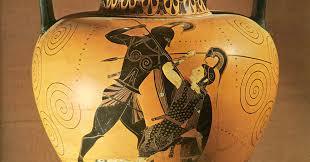
Penthesilea
I had heard of Penthesilea and the Amazons before as a small girl. But the first time I really understand just how impressive and unusual it was in the ancient world to be a woman who “fights with men” was when I was taking Latin at my English girls’ boarding school. Contrary to popular belief, Penthesilea’s story isn’t actually told in the Iliad (which ends with Hector’s funeral, before the Amazons arrive), but in a lost ancient epic called Aethiopis. This poem continued the story of Achilles’ great deeds, which included the killing of several famous warriors—Memnon, King of Aethiopia, and Penthesilea most prominent among them.
The Amazons had a number of famous Queens, but Penthesilea is perhaps the most storied. She was a daughter of the war-god Ares, and Pliny credits her with the invention of the battle-ax. She was also sister to Hippolyta, who married the hero Theseus, after being defeated by him in battle. Penthesilea ruled the Amazons during the years of the Trojan war—and for most of that time stayed away from the conflict. However, after Achilles killed Hector, Penthesilea decided it was time for her Amazons to intervene, and the group rode to the rescue of the Trojans—who were, after all, fellow Anatolians. Fearless, she blazed through the Greek ranks, laying waste to their soldiers.
During the battles, Penthesilea was not a queen who sat by and watched the men fight. She was a warrior in the truest sense. It is said that she blazed through the Greeks like lightning, killing many. It is written that she was swift and brave, and fought as valiantly and successfully as the men. She wanted to prove that the Amazons were great warriors. She wanted to kill Achilles to avenge the death of Hector, and she wanted to die in battle. I love Vergil’s glorious description of her in battle: “The ferocious Penthesilea, gold belt fastened beneath her exposed breast, leads her battle-lines of Amazons with their crescent light-shields…a warrioress, a maiden who dares to fight with men.”
Although Penthesilea was a ferocious warrior, her life came to an end, at the hands of Achilles. Achilles had seen her battling others, and was enamored with her ferocity and strength. As he fought, he worked his way towards her, like a moth drawn to a flame. While he was drawn to her with the intention of facing her as an opponent, he fell in love with her upon facing her. However, it was too late.
Achilles defeated Penthesilea, catching her as she fell to the ground. Greek warrior Thersites mocked Achilles for his treatment of Penthesilea’s body after her death. It is also said that Thersites removed Penthesilea’s eyes with his sword. This enraged Achilles, and he slaughtered Thersites. Upon Thersites’ death, a sacred feud was fought. Diomedes, Thersite’s cousin, retrieved Penthesilea’s corpse, dragged it behind his chariot, and cast it into the river. Achilles retrieved the body, and gave her a proper burial. In some stories, Achilles is accused of engaging in necrophilia with her body. In other legends, it is said that Penthesilea bore Achilles a son after her death. Yes, I agree, that does feel creepy.
Penthesilea’s life and death were tragic. She is portrayed as a brave and fierce warrior who was deeply affected by the accidental death of her sister. This grief, compounded with her desire to be a strong warrior who would die an honourable death on the battlefield, led her to Troy, where her tragic death weakened Troy, but also led to unrest in the Greek camps due to her death’s impact on Achilles and his revengeful acts. In the end, she died the ‘honorable’ death on the battlefield that she had longed for, at the hands of the legendary Achilles, no less.
The heroines of Greek mythology tend towards thoughtfulness, fidelity and modesty (Andromache, Penelope), while the daring and headstrong personalities generally go to the antagonists–Medea, Clytemnestra, Hera. But Penthesilea is something else entirely: a woman who meets men on her own terms, as their equal. Perhaps in honour of this, Virgil doesn’t give her the standard heroine epithet of “beautiful.” For him, it is her majesty and obvious power that make her notable, not her looks.
By the way, the word that Virgil uses for warrioress is bellatrix, the inspiration for Bellatrix Lestrange’s name in the Harry Potter books. So she lives on in immortality through our modern day Virgil, J.K. Rowling (just kidding)

Cynane (c. 358 – 323 BC)
Cynane was the daughter of King Philip II of Macedon and his first wife, the Illyrian Princess Audata. She was also the half-sister of Alexander the Great. Audata raised Cynane in the Illyrian tradition, training her in the arts of war and turning her into an exceptional fighter – so much so that her skill on the battlefield became famed throughout the land. Cynane accompanied the Macedonian army on campaign alongside Alexander the Great and according to the historian Polyaenus, she once slew an Illyrian queen and masterminded the slaughter of her army. Such was her military prowess. Following Alexander the Great’s death in 323 BC, Cynane attempted an audacious power play. In the ensuing chaos, she championed her daughter, Adea, to marry Philip Arrhidaeus, Alexander’s simple-minded half-brother who the Macedonian generals had installed as a puppet king. Yet Alexander’s former generals – and especially the new regent, Perdiccas – had no intention of accepting this, seeing Cynane as a threat to their own power. Undeterred, Cynane gathered a powerful army and marched into Asia to place her daughter on the throne by force.
As she and her army were marching through Asia towards Babylon, Cynane was confronted by another army commanded by Alcetas, the brother of Perdiccas and a former companion of Cynane. However, desiring to keep his brother in power Alcetas slew Cynane when they met – a sad end to one of history’s most remarkable female warriors. Although Cynane never reached Babylon, her power play proved successful. The Macedonian soldiers were angered at Alcetas’ killing of Cynane, especially as she was directly related to their beloved Alexander. Thus they demanded Cynane’s wish be fulfilled. Perdiccas relented, Adea and Philip Arrhidaeus were married, and Adea adopted the title Queen Adea Eurydice.

Olympias and Eurydice
The mother of Alexander the Great, Olympias was one of the most remarkable women in antiquity. She was a princess of the most powerful tribe in Epirus (a region now divided between northwest Greece and southern Albania) and her family claimed descent from Achilles. Despite this impressive claim, many Greeks considered her home kingdom to be semi-barbarous – a realm tainted with vice because of its proximity to raiding Illyrians in the north. Thus the surviving texts often perceive her as a somewhat exotic character.
In 358 BC Olympias’ uncle, the Molossian King Arrybas, married Olympias to King Philip II of Macedonia to secure the strongest possible alliance. She gave birth to Alexander the Great two years later in 356 BC. Further conflict was added to an already tempestuous relationship when Philip married again, this time a Macedonian noblewoman called Cleopatra Eurydice.
Olympias began to fear this new marriage might threaten the possibility of Alexander inheriting Philip’s throne. Her Molossian heritage was starting to make some Macedonian nobles question Alexander’s legitimacy. Thus there is a strong possibility that Olympias was involved in the subsequent murders of Philip II, Cleopatra Eurydice and her infant children. She is often portrayed as a woman who stopped at nothing to ensure Alexander ascended the throne. Following Alexander the Great’s death in 323 BC, she became a major player in the early Wars of the Successors in Macedonia. In 317 BC, she led an army into Macedonia and was confronted by an army led by another queen: none other than Cynane’s daughter, Adea Eurydice.
This clash was the first time in Greek history that two armies faced each other commanded by women. However, the battle ended before a sword blow was exchanged. As soon as they saw the mother of their beloved Alexander the Great facing them, Eurydice’s army deserted to Olympias. Upon capturing Eurydice and Philip Arrhidaeus, Eurydice’s husband, Olympias had them imprisoned in squalid conditions. Soon after she had Philip stabbed to death while his wife watched on.
On Christmas Day 317, Olympias sent Eurydice a sword, a noose, and some hemlock, and ordered her to choose which way she wanted to die. After cursing Olympias’ name that she might suffer a similarly sad end, Eurydice chose the noose. Olympias herself did not live long to cherish this victory. The following year Olympias’ control of Macedonia was overthrown by Cassander, another of the Successors. Upon capturing Olympias, Cassander sent two hundred soldiers to her house to slay her.
However, after being overawed by the sight of Alexander the Great’s mother, the hired killers did not go through with the task. Yet this only temporarily prolonged Olympias’ life as relatives of her past victims soon murdered her in revenge.

Artemisia I of Caria (5th Century BC)
Named after the Goddess of the Hunt (Artemis), Artemisia was the 5th century BCE Queen of Halicarnassus, a kingdom that exists in modern-day Turkey. However, she was best known as a naval commander and ally of Xerxes, the King of Persia, in his invasion of the Greek city-states. (Yes, like in the action movie 300: Rise of an Empire.) She made her mark on history in the Battle of Salamis, where the fleet she commanded was deemed the best against the Greeks. Greek historian Herodotus wrote of her heroics on this battlefield of the sea, painting her as a warrior who was decisive and incredibly intelligent in her strategies. This included a ruthless sense of self-preservation. With a Greek vessel bearing down on her ship, Artemisia intentionally steered into another Persian vessel to trick the Greeks into believing she was one of them. It worked. The Greeks left her be. The Persian ship sank. Watching from the shore, Xerxes saw the collision and believed Artemisia had sunk a Greek enemy, not one of his own.
For all of this, her death was not one recorded in a great battle, but in legends written by the victors, the Greeks - so one must obviously be skeptical of accepting what they said as 100% truth. It's said that Artemisia fell hard for a Greek man, who ignored her to his detriment. Blinded by love, she blinded him in his sleep. Yet even with him disfigured, her passion for him burned. To cure herself, she set to leap from a tall rock in Leucas, Greece, which was believed to break the bonds of love. Instead, it broke Artemisia's neck. She's said to be buried nearby.
But much like Penthesilea, she lives on in our modern culture, but arguably more dubiously through Hollywood in the sub-par action movie 300: Rise of an Empire. Now I forever think of Artemisia as the beautiful and sultry French actress, Eva Green.
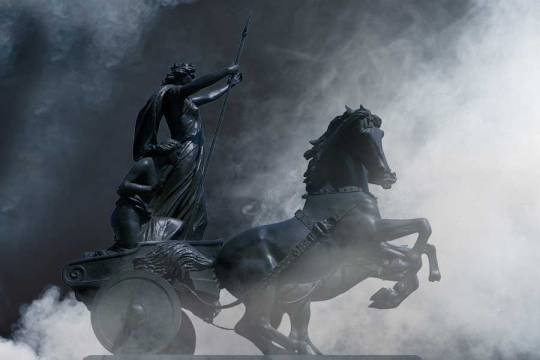
Boadicea (also written as Boudica)
Boadicea was a Celtic queen who led a revolt against Roman rule in ancient Britain in A.D. 60 or 61. As all of the existing information about her comes from Roman scholars, particularly Tacitus and Cassius Dio, little is known about her early life; it’s believed she was born into an elite family in Camulodunum (now Colchester) around A.D. 30.
At the age of 18, Boudica married Prasutagas, king of the Iceni tribe of modern-day East Anglia. When the Romans conquered southern England in A.D. 43, most Celtic tribes were forced to submit, but the Romans let Prasutagas continue in power as a forced ally of the Empire. When he died without a male heir in A.D. 60, the Romans annexed his kingdom and confiscated his family’s land and property. As a further humiliation, they publicly flogged Boadicea and raped her two daughters. Tacitus recorded Boudicca’s promise of vengeance after this last violation: “Nothing is safe from Roman pride and arrogance. They will deface the sacred and will deflower our virgins. Win the battle or perish, that is what I, a woman, will do.”
Like other ancient Celtic women, Boadicea had trained as a warrior, including fighting techniques and the use of weapons. With the Roman provincial governor Gaius Suetonius Paulinus leading a military campaign in Wales, Boadicea led a rebellion of the Iceni and members of other tribes resentful of Roman rule. After defeating the Roman Ninth Legion, the queen’s forces destroyed Camulodunum, then the captain of Roman Britain, and massacred its inhabitants. They went on to give similar treatment to London and Verulamium (modern St. Albans). By that time, Suetonius had returned from Wales and marshaled his army to confront the rebels. In the clash that followed–the exact battle site is unknown, but possibilities range from London to Northamptonshire–the Romans managed to defeat the Britons despite inferior numbers, and Boadicea and her daughters apparently killed themselves by taking poison in order to avoid capture.
In all, Tacitus claimed, Boadicea’s forces had massacred some 70,000 Romans and pro-Roman Britons. Though her rebellion failed, and the Romans would continue to control Britain until A.D. 410, Bouadicea is celebrated today as a British national heroine and an embodiment of the struggle for justice and independence.
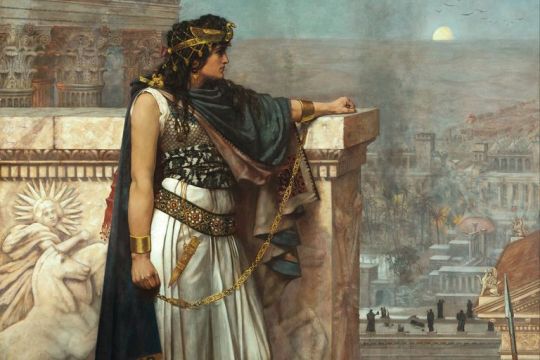
Queen Zenobia
In the 3rd century AD, Queen Zenobia, natively know as Bath Zabbai, was a fierce ruler of Palmyra, a region in modern day Syria. Throughout her life, Zenobia became known as the ‘warrior queen’. She expanded Palmyra from Iraq to Turkey, conquered Egypt and challenged the dominance of Rome.
“Zenobia was esteemed the most lovely as well as the most heroic of her sex,” Gibbon wrote in an awestruck account of her brief reign. “She claimed her descent from the Macedonian kings of Egypt, equaled in beauty her ancestor Cleopatra, and far surpassed that princess in chastity and valour.” The only contemporary representation we have of Zenobia is on a coin, which makes her look rather witchlike, but Gibbon’s description of her pearly-white teeth and large black eyes, which “sparkled with uncommon fire,” cast a spell over future historians, both in the West and in the Arab world, who quarrel over nearly everything having to do with Zenobia and her confounding legacy.
Many legends have arisen about Zenobia’s identity, but it seems she was born into a family of great nobility who claimed the notorious Queen Dido of Carthage and Cleopatra VII of Egypt as ancestors. She was given a Hellenistic education, learning Latin, Greek, the Syriac and Egyptian languages. According to the Historia Augusta her favourite childhood hobby was hunting, and she proved to be a brave and brilliant horsewoman.
Despite this, many ancient sources seem to gravitate to one quality – that she was an exceptional beauty who captivated men across the whole of Syria with her ravishing looks and irresistible charm.
She was probably in her twenties when she took the throne, upon the death of her husband, King Odenathus, in 267 or 268. Acting as regent for her young son, she then led the army in a revolt against the Romans, conquering Egypt and parts of Asia Minor. By 271, she had gained control of a third of the Roman Empire. Gibbon sometimes portrays the warrior queen as a kind of well-schooled Roman society matron. “She was not ignorant of the Latin tongue,” he writes, “but possessed in equal perfection the Greek, the Syriac, and the Egyptian languages.” Palmyra’s abundant wall inscriptions are in Latin, Greek, and an Aramaic dialect, not Arabic. But to Arab historians, such as the ninth-century al-Tabari, Zenobia was a tribal queen of Arab, rather than Greek, descent, whose original name was Zaynab, or al-Zabba. Among Muslims, she is seen as a herald of the Islamic conquests that came four centuries later.
This view, popular within the current Syrian regime, which boasts Zenobia on its currency, also resonates within radical Islamic circles. Isis radical fighters have believed Palmyra to be somehow a distinctively Arab place, where Zenobia stood up to the Roman emperor.” Indeed, Isis fighters, after seizing Palmyra, released a video showing the temples and colonnades at the ruins, a unesco World Heritage site, intact. “Concerning the historical city, we will preserve it,” an Isis commander, Abu Laith al-Saudi, told a Syrian radio station. “What we will do is pulverise the statues the miscreants used to pray to.” Fighters then set about sledgehammering statues and shrines.
Zenobia’s nemesis was the Roman emperor Aurelian, who led his legions through Asia Minor, reclaiming parts of the empire she had taken. Near Antioch, she met him with an army of seventy thousand men, but the Roman forces chased them back to their desert stronghold. During the siege of the city, Aurelian wrote to Zenobia, “I bid you surrender, promising that your lives shall be spared.” She replied, “You demand my surrender as though you were not aware that Cleopatra preferred to die a queen rather than remain alive.” Zenobia attempted to escape to Persia, but was captured before she could cross the Euphrates. Palmyra was sacked after a second revolt. Aurelian lamented in a letter to one of his lieutenants, “We have not spared the women, we have slain the children, we have butchered the old men.”
Some Arab sources adhere to the theory that Zenobia committed suicide before she could be caught. Gibbon follows Roman accounts that place her in Rome as the showpiece of Aurelian’s triumphal procession. “The beauteous figure of Zenobia was confined by fetters of gold; a slave supported the gold chain which encircled her neck, and she almost fainted under the intolerable weight of jewels,” he writes. The grand homecoming apparently elicited a snarky response from the commentariat. According to the “Historia Augustus,” Aurelian complained, “Nor would those who criticise me, praise me sufficiently, if they knew what sort of woman she was.” Instead of beheading her in front of the Temple of Jupiter, once a common fate of renegades, he awarded her a villa in Tivoli. The historian Syncellus reported that she married a Roman senator; their descendants were listed into the fifth century. She is said to have died in 274 AD in Rome.
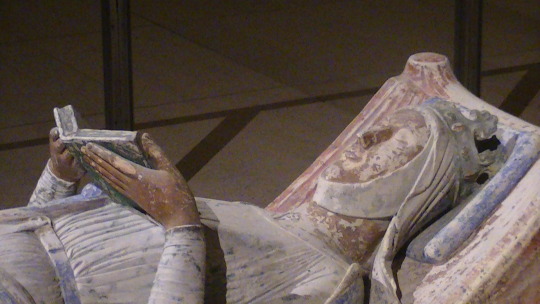
Eleanor of Aquitaine (1122-1204)
Eleanor was a formidable Queen twice over – first as Queen of France, then of England! Her father William X died in 1137, leaving Eleanor to inherit his titles, lands and enormous wealth at just 15. Suddenly one of France’s most eligible bachelorettes, she married Louis, son of the French King, and not long after became Queen of France, still in her teens.
Famously fierce and tenacious, Eleanor exerted considerable influence over Louis, and accompanied him on the Second Crusade of 1147-49. After their marriage was annulled in 1152, she stayed single for just two months before marrying the heir to the English throne Henry Plantagenet, and in 1154 they were crowned King and Queen of England. Eleanor took a leading role in running the country, directing church and state affairs when Henry was away, and travelling extensively to consolidate their power across England. This was all while raising eight children, and finding time to be a great patron of courtly love poetry!
Eleanor and Henry separated in 1167, and after Eleanor sided with her children over Henry during a revolt, she became Henry’s prisoner. She was held under house arrest for over a decade, and it was only in 1189 after Henry died and her son Richard the Lionheart became king that Eleanor was freed.
By now a widow in her 70s, instead of retiring to a quiet life away from court politics, Eleanor became more badass than ever. While Richard was away on crusade she took a leading role once again in running the realm and fending off threats of attack, and when he was taken hostage by the Duke of Austria she personally collected his ransom money and travelled to Austria to deliver it and ensure his safe return to England.
After spending many of her final years criss-crossing France and Spain on diplomatic and military missions, Eleanor died in 1204 at a monastery in Anjou. The nuns there described her as a queen ‘who surpassed almost all the queens of the world’.
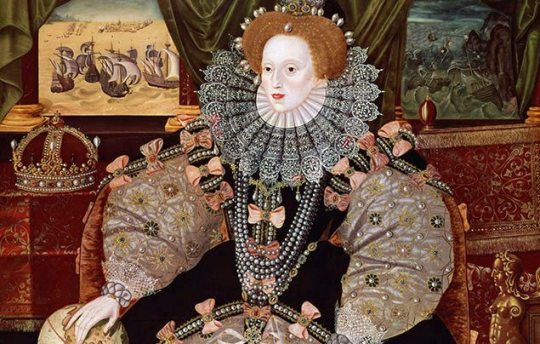
Elizabeth I of England (1533-1603)
Elizabeth I is one of my favourite Queens of all time. She reigned for 45 years and is well remembered for her defeat of the Spanish Armada, her progresses, her economic policies, and her patronage of the arts – as well as her virginity. The history books talk much of her make-up and spinsterhood, but there is no doubt that she was one of the most badass monarchs England ever had.
Elizabeth’s early life did not start well. By the age of three, her father had had her mother executed, and Elizabeth had been deemed illegitimate. Nonetheless she was given a rigorous education. One tutor even noted that her mind showed “no womanly weakness”. She excelled at Greek, Latin, French and Italian, as well as theology – knowledge that would equip her for diplomatic leadership so necessary in later life.
In 1554, under the reign of her devout Catholic sister Mary, Elizabeth became the focus of a Protestant rebellion. She was arrested and sent to the Tower of London, but was found innocent and escaped with her life a few months later. Her true commitment to the reformed church was only openly revealed upon her accession to the throne.
Indeed, as Queen Elizabeth promptly expressed her support for the Protestant church, and yet her reign is celebrated for bringing relative religious stability to the country. She adopted a policy to not “make windows into men’s souls”, which allowed for a margin of freedom beyond that of the monarchs before her. Her astute appointment of ministers and officials along with careful housekeeping also led to a period of relative economic stability, which in turn allowed for the arts to flourish during this time. Elizabeth attended the first performance of Shakespeare’s A Midsummer Night’s Dream and appointed the acclaimed miniaturist Nicholas Hilliard as a court painter.
Elizabeth’s choice not to marry was radical (and wholly understandable given her monster for a father and abusive step-father.) Yet, throughout her reign the expectation remained that she would find a husband and give birth to an heir. Instead, the Queen used her ‘eligible bachelor’ position as a political tool, while creating an image of herself as married to the nation. Her popularity with her subjects and her own self-styled image as Gloriana made Good Queen Bess into a legendary figure; today, she has been portrayed in more films and television shows than any other British monarch.
Her most amazing achievement is the fact that her name defined a chapter of Western history so that even today we talk of Elizabethan era. A feat matched only by Queen Victoria to define the 19th Century.
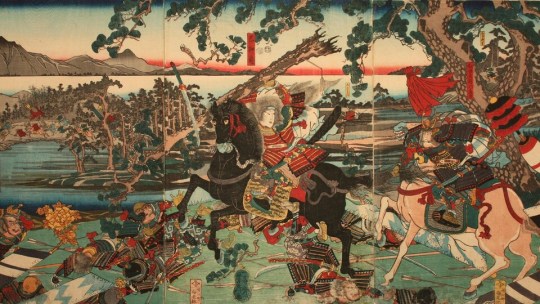
Tomoe Gozen
When I was living in Japan as a child I began to appreciate Japanese history. I also took an interest in the Japanese martial arts as well as being thrown in at the deep end to struggle to learn the language. So as an outsider I was happy to discover that Japanese women were not always demure and subservient or even passive witnesses to history. Some even made it. Outsiders don’t truly know how some Japanese women had shaped their own destiny as well as their country’s within the constraints of the rigid social structures of Japanese society. Contrary to what many think there were indeed female samurai. Not many but one or two who became the stuff of legend and lore.
The most famous onna-bugeisha (female samurai) in Japanese history was Tomoe Gozen. Gozen was a title of respect bestowed on her by her master, shogun Minamoto no Yoshinaka. She fought alongside male samurais in the Genpei War, which lasted from 1180 to 1185. While a woman fighting among men was highly unusual, it seems Yoshinaka's high esteem for Tomoe and her fighting skills overcame prejudice.
In the history tome The Tale of Heike, Tomoe was described as "a remarkably strong archer, and as a swordswoman she was a warrior worth a thousand, ready to confront a demon or a god, mounted or on foot." She was also said to be beautiful, fearless, and respected.
Her hobbies included riding wild horses down intimidatingly steep hills. She regularly led men into battle and to victory. Her last was the Battle of Awazu, where Minamoto no Yoshinaka was killed. Tomoe escaped her enemies there, and gave up her sword and bowed to retirement. From there, some say she married. Years later, when her husband died, it's believed Tomoe became a nun.
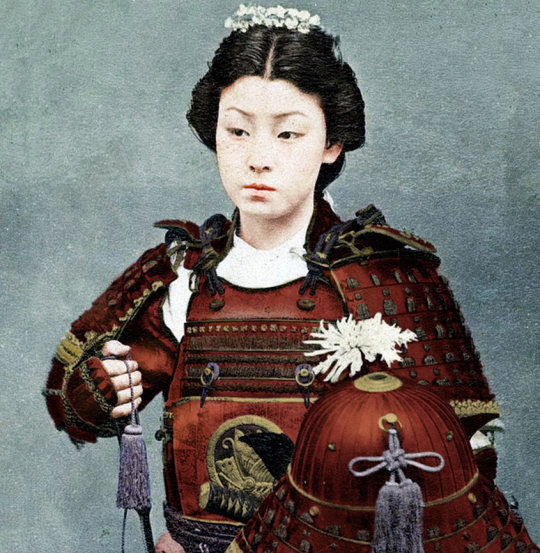
Nakano Takeko
The other known onna-bugeisha (female samurais) in Japan's history, Takeko was educated in literary and martial arts before distinguishing herself in the Boshin War, a Japanese civil war that lasted from January 3rd May 1868 to 18th May 1869.
In the Battle of Aizu in the fall of 1868, she and other females who chose to fight were not recognised as an official part of the Aizu army. Nonetheless, Takeko led her peers in a unit that was later dubbed Jōshitai, which translates to the "Women's Army." Her weapon of choice was the naginta, a Japanese pole arm. But while it helped her earn glory, it would not safeguard her through the war.
Takeko was shot in the chest while leading a charge against the Imperial Japanese Army of the Ogaki domain. Fearing that her enemies would defile her body and make her head a gruesome war trophy, she asked her sister to cut it off and bury it. This was her final wish, and her head was subsequently buried beneath a pine tree at the Hōkai-ji Temple in modern-day Fukushima. Today, a monument to her stands nearby, where girls come each year to honour her and her Women's Army during the Aizu Autumn Festival.

Laxmibai, the Rani of Jhansi (1828-1858)
Laxmibai would have made any of warrior women of Classical antiquity proud. She was the last of the true warrior queens. The fact she was Indian and bitterly fought the British to the death doesn’t deter me from admiring her hugely in the same way the British still admire Joan of Arc.
Like many other families scattered across the British Empire, my family lost brave relatives who died during the tragic Indian Mutiny of 1857 (the Indians call it the First War for Independence). But however ugly and bloody that chapter of British imperial history was, I find myself in awe of the life of Laxmibai, the Rani of Jhansi.
When as a family we moved to India I learned a little about her from Indian school friends. I learned a lot more from a couple of Indian officer cadets at Sandhurst (Sandhurst takes in officer cadets from the Commonwealth and other countries) with whom I struck an affable friendship because I could speak Hindi and we used to watch Bollywood movies with our platoon mates. Laxmibai is every bit as remarkable as Jeanne d’Arc and much more. I can say I am humbled when I try to retrace her steps of her life when I visit India from time to time.
By the time Laxmibai (or Lakshmibai) was a teenager, she had already violated many of the expectations for women in India’s patriarchal society. She could read and write. She had learned to ride a horse and wield a sword. She talked back to anyone who tried to tell her to live her life differently. But where those spirited ways might have been scorned in another young Indian woman, they would prove to serve her well as she went on to leave an indelible mark on Indian history.
In the mid-19th century, what became the modern nation of India was dotted with hundreds of princely states, one of which, Jhansi, in the north, was ruled by Queen Laxmibai. Her reign came at a pivotal time: The British, who were expanding their presence in India, had annexed her realm and stripped her of power. Laxmibai tried to regain control of Jhansi through negotiations, but when her efforts failed she joined the Indian Rebellion of 1857, an uprising of soldiers, landowners, townspeople and others against the British in what is now known as India’s first battle for independence. It would be 90 years before the country would finally uproot the British, in 1947.
The queen, or rani, went on to train and lead her own army, composed of both men and women, only to perish on the battlefield in June 1858. In the decades that followed, her life became a subject of competing narratives. Indians hailed her as a heroine, the British as a wicked, Jezebel-like figure. But somewhere between these portrayals she emerged as a symbol not just of resistance but of the complexities associated with being a powerful woman in India.
Laxmibai wasn’t of royal blood. Manakarnika, as she was named at birth, is widely believed to have been born in 1827 in Varanasi, a city in northeast India on the banks of the Ganges River. She was raised among the Brahmin priests and scholars who sat atop India’s caste system. Her father worked in royal courts as an adviser, giving her access to an education, as well as horses. In 1842, Manakarnika married Maharaja Gangadar Rao, the ruler of Jhansi, and took on the name Laxmibai. (It was — and, in some parts of the country, still is — a common practice for women to change their names after marriage.)
By most accounts she was an unconventional queen, and a compassionate one. She refused to abide by the norms of the purdah system, under which women were concealed from public view by veils or curtains. She insisted on speaking with her advisers and British officials face to face. She wore a turban, an accessory more common among men. And she is said to have trained women in her circle to ride and fight. She attended to the poor, regardless of their caste, a practice that even today would be considered bold in parts of India. While she was queen, the powerful British East India Company was beginning to seize more land and resources. In 1848, Lord Dalhousie, India’s governor general, declared that princely states with leaders lacking natural born heirs would be annexed by the British under a policy called the ‘Doctrine of Lapse’.
Laxmibai’s only child had died, and her husband’s health was starting to deteriorate. The couple decided to adopt a 5 year-old boy to groom as successor to the throne, and hoped that the British would recognize his authority despite the declaration. “I trust that in consideration of the fidelity I have evinced toward government, favour may be shown to this child and that my widow during her lifetime may be considered the Regent,” her husband, the maharaja, wrote in a letter, as quoted in Rainer Jerosch's book, “The Rani of Jhansi: Rebel Against Will” (2007). His pleas were ignored. Soon after he died, in 1853, the East India Company offered the queen a pension if she agreed to cede control. She refused, exclaiming: “Meri Jhansi nahin dungee” (“I will not give up my Jhansi”) - a Hindi phrase that to this day is etched into India’s memory, stirring up feelings of pride and patriotism.
Beyond Jhansi’s borders, a rebellion was brewing as the British imposed their social and Christian practices and banned Indian customs. The uprising spread from town to town, reaching Jhansi in June 1857. Dozens of British were killed in the ensuing massacre by the rebels. The British turned on Laxmibai, accusing her of conspiring with the rebels to seek revenge over their refusal to recognize her heir. Whether or not she did remains disputed. Some accounts insist that she was wary of the rebels and that she had even offered to protect British women and children during the violence.
Tensions escalated, and in early 1858 the British stormed Jhansi’s fortress.
“Street fighting was going on in every quarter,” Dr. Thomas Lowe, the army’s field surgeon, wrote in his 1860 book “Central India During the Rebellion of 1857 and 1858.” “Heaps of dead lay all along the rampart and in the streets below….Those who could not escape,” he added, “threw their women and babies down wells and then jumped down themselves.” As the town burned, the queen escaped on horseback with her son, Damodar, tied to her back.
Historians have not reached a consensus on how she managed to pull this off. Some contend that her closest aide, Jhalkaribai, disguised herself as the queen to distract the British and buy time for her to get away.
In the end, the British took the town, leaving 3,000 to 5,000 people dead, and hoisted the British flag atop the palace. Left with no other options, Laxmibai decided to join the rebel forces and began training an army in the nearby state of Gwalior.
The British troops, close on her heels, attacked Gwalior on a scorching summer morning in June 1858. She led a countercharge — “clad in the attire of a man and mounted on horseback,” the British historians John Kaye and George Malleson wrote in “History of the Indian Mutiny” (1890) — and was killed. However accounts differ on whether she was stabbed with a saber or struck by a bullet. It was the last battle in the Indian Rebellion.
“The Indian Mutiny had produced but one man,” Sir Hugh Rose, the leader of the British troops, reportedly said when fighting ended, “and that man was a woman.”
The violence left thousands dead on both sides. The British government dissolved the East India Company over concerns about its aggressive rule and brought India under the control of the Crown. It then reversed Lord Dalhousie’s policy of annexing kingdoms without heirs.
Today, Queen Laxmibai of Jhansi has been immortalised in India’s nationalist narrative. There are movies, TV shows, books and even nursery rhymes about her. Streets, colleges and universities are named after her. Young girls dress up in her likeness, wearing pants, turbans and swords. Statues of her on horseback, with her son tied to her back, have been erected in many cities throughout India.
And, almost a century after her death, the Indian National Army formed an all-female unit that aided the country in its battle for independence in the 1940s. It was called the Rani of Jhansi regiment.

There are plenty of other women that one could write about of great women leaders who while not on the front line of battle did lead their countries to greatness or skilfully pulled the strings from behind the throne. History is littered with many examples.
What metrics we determine to define ‘greatness” is very much in the eye of the beholder. It’s not a matter of masculine or feminine virtues - although they are important in their own way. Above all I would say what makes a leader great is character.
There is no ‘weaker sex’ - that would be a terribly unfair slur on our men.
I’m joking of course. But my point stands. I don’t believe it’s about who is the weaker sex. But let’s talk of character instead.
Character defines the essence of leadership. I say this because I often encounter a perception among women that they need to become more like men to be considered equal to them. Nothing could be further from the truth. What makes you uniquely who you are as a woman is highly important.
We are all called to become the best versions of ourselves, and as women, we don’t do that by trying to be more like men. It would be a mistake to put one’s heroines on a pedestal because they are all flawed and have feet of clay - just like men. Character knows no gender. Character is virtuous. Character is rising to greatness despite one’s flaws.
As early as the 1300s, Catherine of Sienna wisely said, “Be who you were created to be, and you will set the world on fire.” More than 500 years later, Oscar Wilde reiterated that notion: “Be yourself, everyone else is already taken.”
So be the best version of yourself.
Thanks for your question.
#question#ask#warrior#women#femme#leadership#history#military history#heroines#napoleon#alexander#personal
105 notes
·
View notes